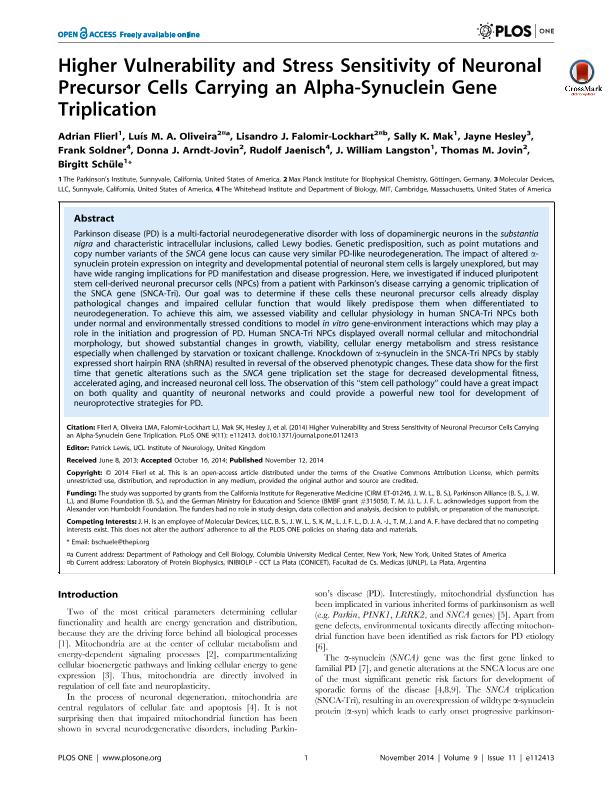Mostrar el registro sencillo del ítem
dc.contributor.author
Flierl, Adrian
dc.contributor.author
Oliveira, Luis M. A.
dc.contributor.author
Falomir Lockhart, Lisandro Jorge

dc.contributor.author
Mak, Sally K.
dc.contributor.author
Hesley, Jayne
dc.contributor.author
Soldner, Frank
dc.contributor.author
Arndt Jovin, Donna J.
dc.contributor.author
Jaenisch, Rudolf
dc.contributor.author
Langstom, J. William
dc.contributor.author
Jovin, Thomas M.
dc.contributor.author
Schüle, Birgitt
dc.date.available
2018-01-22T21:10:48Z
dc.date.issued
2014-11
dc.identifier.citation
Flierl, Adrian; Oliveira, Luis M. A.; Falomir Lockhart, Lisandro Jorge; Mak, Sally K.; Hesley, Jayne; et al.; Higher Vulnerability and Stress Sensitivity of Neuronal Precursor Cells Carrying an Alpha-Synuclein Gene Triplication; Public Library of Science; Plos One; 9; 11; 11-2014; 1-15; e112413
dc.identifier.issn
1932-6203
dc.identifier.uri
http://hdl.handle.net/11336/34203
dc.description.abstract
Parkinson disease (PD) is a multi-factorial neurodegenerative disorder with loss of dopaminergic neurons in the substantia nigra and characteristic intracellular inclusions, called Lewy bodies. Genetic predisposition, such as point mutations and copy number variants of the SNCA gene locus can cause very similar PD-like neurodegeneration. The impact of altered α-synuclein protein expression on integrity and developmental potential of neuronal stem cells is largely unexplored, but may have wide ranging implications for PD manifestation and disease progression. Here, we investigated if induced pluripotent stem cell-derived neuronal precursor cells (NPCs) from a patient with Parkinson’s disease carrying a genomic triplication of the SNCA gene (SNCA-Tri). Our goal was to determine if these cells these neuronal precursor cells already display pathological changes and impaired cellular function that would likely predispose them when differentiated to neurodegeneration. To achieve this aim, we assessed viability and cellular physiology in human SNCA-Tri NPCs both under normal and environmentally stressed conditions to model in vitro gene-environment interactions which may play a role in the initiation and progression of PD. Human SNCA-Tri NPCs displayed overall normal cellular and mitochondrial morphology, but showed substantial changes in growth, viability, cellular energy metabolism and stress resistance especially when challenged by starvation or toxicant challenge. Knockdown of α-synuclein in the SNCA-Tri NPCs by stably expressed short hairpin RNA (shRNA) resulted in reversal of the observed phenotypic changes. These data show for the first time that genetic alterations such as the SNCA gene triplication set the stage for decreased developmental fitness, accelerated aging, and increased neuronal cell loss. The observation of this “stem cell pathology” could have a great impact on both quality and quantity of neuronal networks and could provide a powerful new tool for development of neuroprotective strategies for PD.
dc.format
application/pdf
dc.language.iso
eng
dc.publisher
Public Library of Science

dc.rights
info:eu-repo/semantics/openAccess
dc.rights.uri
https://creativecommons.org/licenses/by-nc-sa/2.5/ar/
dc.subject
Alpha-Synuclein Triplocation
dc.subject
Parkinson´S Disease
dc.subject
Metabolic Imparement
dc.subject
Oxidative Stress
dc.subject.classification
Otras Ciencias Biológicas

dc.subject.classification
Ciencias Biológicas

dc.subject.classification
CIENCIAS NATURALES Y EXACTAS

dc.title
Higher Vulnerability and Stress Sensitivity of Neuronal Precursor Cells Carrying an Alpha-Synuclein Gene Triplication
dc.type
info:eu-repo/semantics/article
dc.type
info:ar-repo/semantics/artículo
dc.type
info:eu-repo/semantics/publishedVersion
dc.date.updated
2018-01-18T17:16:38Z
dc.journal.volume
9
dc.journal.number
11
dc.journal.pagination
1-15; e112413
dc.journal.pais
Estados Unidos

dc.journal.ciudad
San Francisco
dc.description.fil
Fil: Flierl, Adrian. The Parkinson’s Institute; Estados Unidos
dc.description.fil
Fil: Oliveira, Luis M. A.. Max Planck Institute for Biophysical Chemistry; Alemania
dc.description.fil
Fil: Falomir Lockhart, Lisandro Jorge. Max Planck Institute for Biophysical Chemistry; Alemania. Consejo Nacional de Investigaciones Científicas y Técnicas; Argentina
dc.description.fil
Fil: Mak, Sally K.. The Parkinson’s Institute; Estados Unidos
dc.description.fil
Fil: Hesley, Jayne. Molecular Devices; Estados Unidos
dc.description.fil
Fil: Soldner, Frank. Massachusetts Institute of Technology; Estados Unidos
dc.description.fil
Fil: Arndt Jovin, Donna J.. Consejo Nacional de Investigaciones Científicas y Técnicas; Argentina
dc.description.fil
Fil: Jaenisch, Rudolf. Massachusetts Institute of Technology; Estados Unidos
dc.description.fil
Fil: Langstom, J. William. The Parkinson’s Institute; Estados Unidos
dc.description.fil
Fil: Jovin, Thomas M.. Consejo Nacional de Investigaciones Científicas y Técnicas; Argentina
dc.description.fil
Fil: Schüle, Birgitt. The Parkinson’s Institute; Estados Unidos
dc.journal.title
Plos One

dc.relation.alternativeid
info:eu-repo/semantics/altIdentifier/doi/http://dx.doi.org/10.1371/journal.pone.0112413
dc.relation.alternativeid
info:eu-repo/semantics/altIdentifier/url/http://journals.plos.org/plosone/article?id=10.1371/journal.pone.0112413
Archivos asociados
